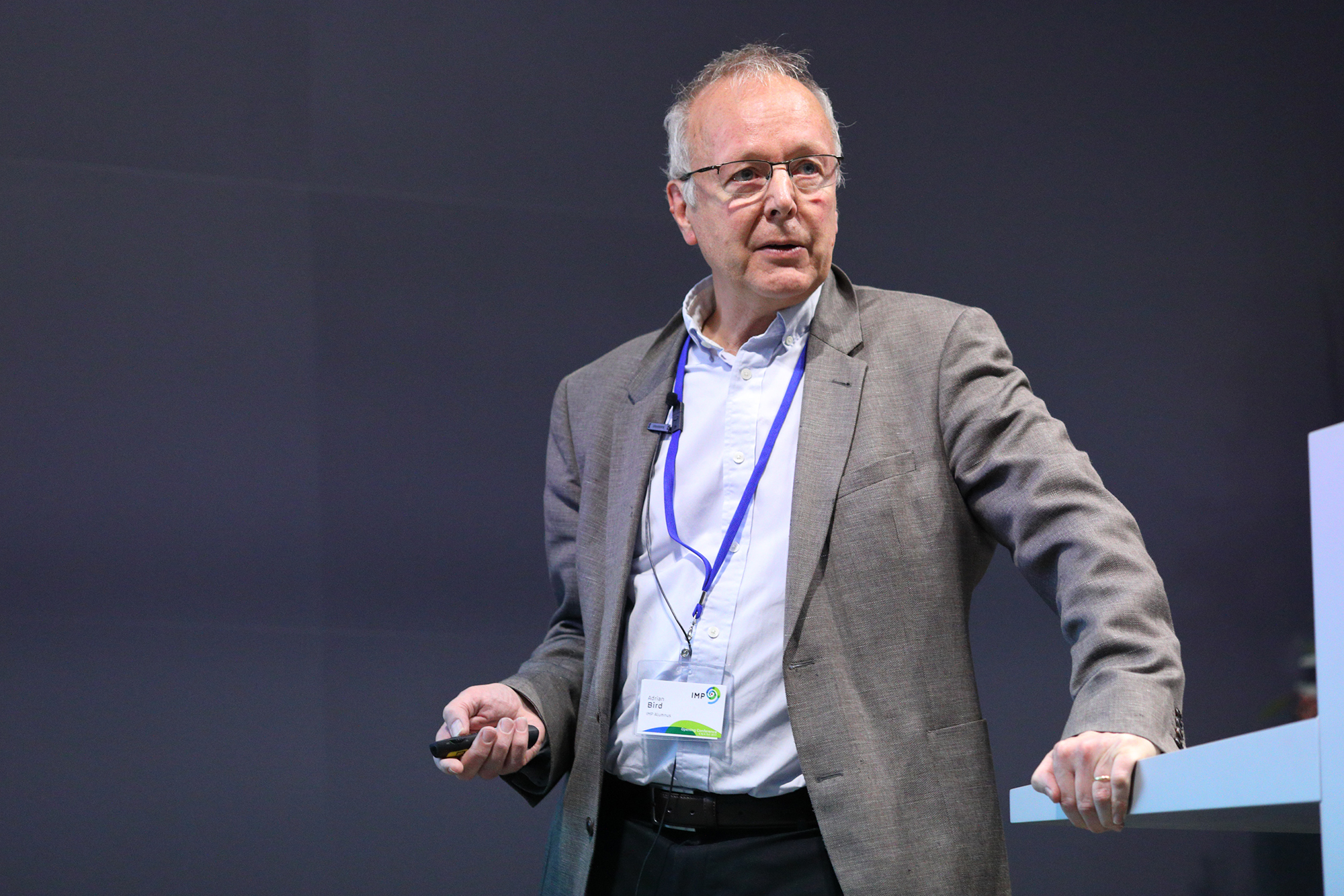DNA methylation and its readers
The methylation of DNA - specifically of the cytosine base in the context CpG - alters the genome without changing its sequence, and was the first epigenetic modification discovered in mammals. Adrian Bird was already an authority on DNA methylation, having led the team that first identified CpG islands in mammalian genomes, when he was recruited to the IMP as one of the first senior scientists in 1987. He spent just three years at the IMP, but published six Cell papers in that short time period – a period that Adrian describes as highly formative for the rest of his career.

In the mid-1980s, Adrian Bird was working at the MRC Mammalian Genome Unit (Edinburgh, United Kingdom), which was headed by Edwin Southern, of Southern blotting fame. Adrian had been there for around a decade, but Southern was leaving, and the MRC had decided to close the unit down. Coincidentally, the building caught fire and suffered major damage. “Altogether, things started to fall apart in a big way”, Adrian says. It was around then that he received a call from Max Birnstiel, his former PhD supervisor, about a new initiative in Vienna, asking if he would be interested in joining. The timing could not have been better, and Adrian agreed. “Vienna was not on the beaten track as far as top class science was concerned. But it was the novelty of it – the fact that two companies, Genentech and Boehringer Ingelheim, were banding together to start a basic science research institute – it sounded quite exciting.”
Adrian had already made a name for himself in the emerging field of DNA methylation – indeed, upon being elected a Fellow of the Royal Society in 1989 (two years after joining the IMP), the nomination described him as “the leading authority on DNA methylation in animal cells”. In Edinburgh, Adrian’s group had discovered CpG islands – CpG-rich regions that are generally unmethylated and frequently found in conjunction with gene promoters. Subsequent work had shown that, while most CpG islands are unmethylated, some are methylated, and that this methylation is associated with repression of transcription.
While investigating the origins of CpG islands, Adrian’s group had found evidence that proteins bind to, and therefore potentially ‘read’, DNA methylation. Continuing this work in Vienna, Paco Antequera, a postdoc in the lab, showed that regions of the genome with high levels of DNA methylation were protected from restriction enzyme cleavage, and that MeCP, a factor that bound methylated DNA in vitro, was likely involved in this protection (Antequera et al., Cell 1989). In a publication in the same issue of Cell, Richard Meehan, another postdoc in the lab, further characterized MeCP, showing it to be a large complex that binds to a variety of unrelated DNA sequences as long as they are symmetrically methylated at multiple CpG sites (Meehan et al., Cell 1989).
So, might binding of MeCP to methylated DNA have something to do with transcriptional repression? It was possible that MeCP binding induced an inaccessible chromatin conformation that would both protect DNA from restriction enzyme cleavage and prevent binding of the transcription machinery. To investigate structural differences between CpG island-associated chromatin and bulk chromatin, Jamal Tazi, another postdoc in the lab, used enzymes that cleave preferentially in either CpG islands or in bulk DNA to isolate the two fractions. He found that CpG island chromatin was characterised by low levels of histone H1, high levels of H3 and H4 acetylation, and the presence of nucleosome-free regions (Tazi & Bird, Cell 1990), supporting the idea that predominantly methylated and predominantly unmethylated regions of the genome are structurally different. In the same year, Paco published his second first-author Cell paper, showing that CpG islands were unexpectedly methylated in many cell lines and that this methylation was accompanied by protection against restriction enzyme cleavage (Antequera et al., Cell 1990).
However, the role of MeCP in these phenomena was unclear. Joan Boyes, one of the first PhD students in the lab and now an Associate Professor at the University of Leeds, set out to test whether MeCP (which they designated MeCP1) was responsible for methylation-mediated inhibition of transcription. To do this, it was clear that she would need a biochemical system. “It was lucky that Meinrad Busslinger’s lab [a neighbouring lab at the IMP] knew how to do in vitro transcription”, Joan says. Setting up the technique in Adrian’s lab, she carried out a series of elegant competition experiments. She showed that DNA methylation-mediated repression in vitro could be overcome by adding methylated competitors that ‘mopped up’ MeCP1. Since she knew from Richard’s paper (Meehan et al., Cell 1989) that embryonal carcinoma cells had much lower levels of MeCP1, she also tested extracts from these cells in the assay. Consistent with the idea that MeCP1 repressed transcription, the extracts were unable to efficiently repress transcription of the methylated templates. Experiments along the same lines, but in vivo, indicated that MeCP1 is also responsible for methylation-mediated repression of transcription in living cells. The findings were published in a fifth Cell paper (Boyes & Bird, Cell 1991) and represented the first demonstration that an epigenetic ‘reader’ can regulate transcription – a concept that has turned out to be one of the most fundamental principles of epigenetic regulation.
Next, the researchers wanted to understand exactly how MeCP1 mediated the repression. However, they had reached a stumbling block – it seemed impossible to purify MeCP1 for biochemical studies. In fact, it was another ten years before MeCP1 was finally purified, by Yi Zhang’s lab at the University of North Carolina, who showed that the complex of ten subunits binds, remodels and deacetylates methylated chromatin (Feng & Zhang, Genes Dev 2001). But in the course of their ultimately unsuccessful purification attempts, Adrian’s lab discovered a new MeCP protein, which they dubbed MeCP2. Although MeCP2 was less of a challenge to purify than MeCP1, it was still a major effort. To determine the sequence of the purified protein, the researchers digested it into small pieces and sent it to Genentech in California for Edman degradation (a technique that determines the amino acid sequence of peptides). But to their dismay they received a letter back from Genentech requesting another lot. The sample had been lost due to an earthquake in California! “I thought that, as an excuse, this was quite novel”, Adrian jokes. Despite the setback, Joe Lewis, another PhD student in the lab, reported the purification, cloning and characterisation of MeCP2 in Cell paper number six (Lewis et al., Cell 1992).
Although there was considerable interest in MeCP2, the protein only really gained the spotlight in 1999, when Huda Zoghbi’s lab at Baylor College of Medicine in Houston identified it as the protein involved in Rett syndrome, a severe and progressive brain disorder (Amir et al., Nature Genetics 1999). Remarkably, Adrian’s lab has since shown that mice with advanced symptoms due to MeCP2 deficiency can essentially be cured by putting the protein back, suggesting that Rett syndrome is reversible (Guy et al., Science 2007). Ironically, at the time Adrian’s group were discovering MeCP2 at the IMP, Andreas Rett, the Austrian neurologist who first described Rett syndrome in 1966, was still working at the Medical School in Vienna. But Adrian never met him, and Rett died before the connection with MeCP2 was made.

Adrian left the IMP in 1990 – a decision that he describes as a very difficult one based on personal reasons – and took up the position of Buchanan Professor of Genetics back at the University of Edinburgh, where he has worked since (without fire, earthquakes or similar!). But the three years at the IMP turned out to be very formative for Adrian’s career. “The work that we’re doing now, still on MeCP2 and to some extent on DNA methylation, has its roots in that period”, he says. “I’m just incredibly grateful that I had the chance to go there at that time.” Adrian has maintained a strong connection with Vienna and the IMP – indeed, he will be joining the IMP’s Scientific Advisory Board in 2020. Attending the opening ceremony of the new IMP building in 2017, he said: “It’s great to see that the IMP goes from strength to strength”.
First published in 2019.
References
Specific protection of methylated CpGs in mammalian nuclei.
Antequera F, Macleod D, Bird AP; Cell 1989
Identification of a mammalian protein that binds specifically to DNA containing methylated CpGs.
Meehan RR, Lewis JD, McKay S, Kleiner EL and Bird AP; Cell 1989
Alternative chromatin structure at CpG islands.
Tazi J, Bird A; Cell 1990
High levels of de novo methylation and altered chromatin structure at CpG islands in cell lines.
Antequera F, Boyes J, Bird A; Cell 1990
DNA methylation inhibits transcription indirectly via a methyl-CpG binding protein.
Boyes J, Bird A; Cell 1991
Purification, sequence, and cellular localization of a novel chromosomal protein that binds to methylated DNA.
Lewis JD, Meehan RR, Henzel WJ, Maurer-Fogy I, Jeppesen P, Klein F, Bird A; Cell 1992
Rett syndrome is caused by mutations in X-linked MECP2, encoding methyl-CpG-binding protein 2.
Amir RE, Van den Veyver IB, Wan M, Tran CQ, Francke U, Zoghbi HY; Nature Genetics 1999
The MeCP1 complex represses transcription through preferential binding, remodeling, and deacetylating methylated nucleosomes.
Feng Q, Zhang Y; Genes Dev 2001
Reversal of neurological defects in a mouse model of Rett syndrome.
Guy J, Gan J, Selfridge J, Cobb S, Bird A; Science 2007